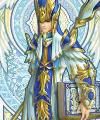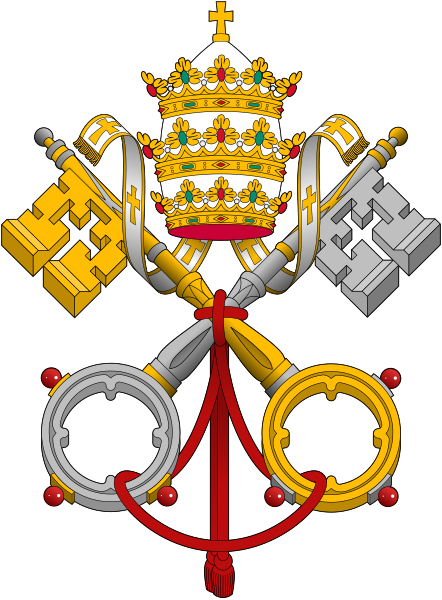mind เขียน:
เคยได้ฟังคุณพ่อเทศน์อยู่ครั้งนึงว่า นักบุญหลุยส์ องค์นี้คือคนเดียวกันกับ หลุยสืที่สลับตัวกับ ฟิลิปส์ในหนังเรื่อง The Man in the Iron Mask อันนี้ไม่รู้จริงอะป่าวฮับพี่Minnie :o
Man in the Iron Mask
From Wikipedia, the free encyclopedia
(Redirected from The Man in the Iron Mask)
Jump to: navigation, search
For other uses, see Man in the Iron Mask (disambiguation).
The Man in the Iron Mask was a prisoner held in a number of prisons, including the Bastille, during the reign of Louis XIV of France. The identity of this man has been thoroughly discussed, mainly because no one ever saw his face as it was hidden by a black velvet mask, which later re-tellings of the story have said to have been an iron mask.
during the reign of Louis XIV of France
ข้อมูลจาก
http://72.14.235.104/search?q=cache:wQO ... =clnk&cd=9
The Prisoner
What facts known about this prisoner are based mainly on correspondence between his jailer and his superiors in Paris.
The first surviving records of the masked prisoner are from July 1, 1669, when Louis XIV's minister the Marquis de Louvois sent a masked prisoner to the care of Bénigne Dauvergne de Saint-Mars, governor of the prison of Pignerol, then part of France.
According to Louvois' letter, the man's name was Eustache Dauger and he had been arrested in Dunkirk. Louvois instructed Saint-Mars to prepare a cell with multiple doors which were to prevent anyone from the outside to listen in. Dauger was also to be told that if he spoke of anything other than his immediate needs he would be killed. Saint-Mars was to see Dauger only once a day in order to provide him with food and whatever else he required. But since the prisoner was "only a valet" he should not require much, according to Louvois.
The first rumors of the prisoner's identity (as a Marshal of France) began to circulate at this point. Although the legend states that the prisoner wore the mask at all times, it is more probable that he was masked only during transport - such as when he was transported from prison to prison - and when there were outside guests in the prison. Another fact is that the mask was not of iron, but a cloth of black velvet.
Saint-Mars' other prisoners at Pignerol included Nicholas Fouquet and the Marquis de Lauzun. Fouquet's cell was above that of Lauzun.
Dauger was not always isolated from the other prisoners. Wealthy and important prisoners usually had menservants; Fouquet for instance was served by a man called La Riviere. Since La Riviere was often ill, Saint-Mars applied for permision for Dauger to act as servant for Fouquet. In 1675 Louvois gave permission for such an arrangement, the conditions being that he was only to serve Fouquet while La Riviere was unavailable and that he was not to meet anyone else: for instance, if Fouquet and Lauzun were to meet, Dauger was not to be present.
After Fouquet's death in 1680, Saint-Mars discovered a secret hole between Fouquet and Lauzun's cells. He was sure that they had communicated through this hole without supervision by him or his guards and thus that Lauzun must have been aware of Dauger's existence. Louvois instructed Saint-Mars to move Lauzun to Fouquet's cell and to tell him that Dauger and La Riviere had been released. In fact they were held in another cell on the opposite side of the prison, their presence there being highly secret.
Lauzun was freed in 1681. Later that same year Saint-Mars was appointed governor of the prison fortress of Exiles. He went there, taking Dauger and La Riviere with him. La Riviere's death was reported in January 1687 and in May Saint-Mars and Dauger moved to the island of Sainte-Marguerite, one of the Lérins Islands.
It was during the journey to Sainte-Marguerite that rumours spread that the prisoner was wearing an iron mask.
On September 18, 1698, Saint-Mars took up his new post as a governor of the Bastille prison, bringing the masked prisoner with him. The prisoner was placed in a solitary cell in the pre-furnished third chamber of the Bertaudiere tower. The prison's second-in-command, de Rosarges, was to feed him. Most of the details of the masked man (continuous wearing of a mask and preferential treatment) come from Lieutenant du Junca of Bastille.
The prisoner died on November 19, 1703, and was buried the next day under the name of Marchioly. All his furniture and clothing were reportedly destroyed afterwards.
[edit]
Vivien de Bulonde
The fate of the mysterious prisoner - and the extent of apparent precautions his jailers took - created much interest and many legends.
One example dates from 1890 when Louis Gendron, a French military historian, came across some coded letters and passed them on to Etienne Bazeries in the French Army's cryptographic department. After three years Bazeries managed to read some messages in the Great Cypher of Louis XIV. One of them referred to a prisoner and identified him as General Vivien de Bulonde. One of the letters written by François de Louvois made specific reference to de Bulonde's crime.
At the siege of Cuneo, Bulonde was concerned about enemy troops arriving from Austria and ordered a hasty withdrawal, leaving behind his munitions and wounded men. Louis XIV was furious and in another of the letters specifically ordered him "to be conducted to the fortress at Pignerole where he will be locked in a cell and under guard at night, and permitted to walk the battlements during the day with a mask". The dates of the letters fit the dates of the original records about the man in the mask.
Some believe that the evidence of the letters means that there is now little need of an alternative explanation for the man in the mask. However, other sources claim that Bulonde's arrest was no secret and was actually published in a newspaper. His death is also recorded as happening in 1709, six years after that of the man in the mask.
There are almost a hundred theories in existence and some others were propounded before the existence of the letters was widely known. Later commentators have still presented their own theories, possibly based on embellished versions of the original tale, mixed with details from stories of other famous contemporary prisoners.
[edit]
The legends and alternative theories
Contemporary claims about his identity included that he was a Marshal of France; or Richard Cromwell; or Francois de Vendôme, Duc de Beaufort. Later, many people from Voltaire to Benjamin Franklin have put forward theories about the man in the mask.
In 1711 the Palatine Princess Charlotte-Elizabeth of Bavaria claimed that the man was an exiled English nobleman who had been involved with the Fenwick affair to depose William III.
Louis XV and XVI have been attributed as saying that the prisoner was Ercole Antonio Mattioli, minister of Duke of Mantua. Mattioli had been involved with Louis XIV's intrigues in Italy and betrayed his secret negotiations with Duke Charles III of Mantua, for the purchase of an important border fortress. He was registered with a prison pseudonym "Lestang".
Voltaire claimed that the prisoner was a son of Mazarin and Anne of Austria and therefore an illegitimate older half-brother of King Louis XIV. How serious he was is hard to say. Alexandre Dumas used this theory in his book, The Vicomte de Bragelonne but made the prisoner a twin brother. It is this book that has been adapted for the four film versions of the story.
In 1801 revolutionary legislator Roux Fazaillac stated that the tale of the masked prisoner was an amalgamation of the fates of two separate prisoners, the abovesaid Mattioli and an imprisoned valet named Eustache Dauger.[1]
In 1801 there emerged a legend, probably created by supporters of Napoleon Bonaparte, that the mysterious prisoner was the real Louis XIV himself and that Cardinal Mazarin had had him replaced by a more suitable candidate. Legend also held that he had married in prison and sired a son, who would have been taken to Corsica to become one of Napoleon's forefathers. This was most probably an intentionally spread political rumor.
One theory is that Eustache Dauger was a valet of imprisoned minister Nicolas Fouquet, also under the guard of Saint-Mars. (The masked man had been assigned to serve as his valet in one point.) After Fouquet's death, the king was afraid that the servant could reveal state secrets if released, so he remained in prison for the next 23 years, until his death. Additional rumors claimed, yet again, that Dauger was in fact twin brother of Louis XIV.
Andrew Lang, in his The Valet's Tragedy and Other Stories (1903), presented a theory that Eustache Dauger was a prison pseudonym of a man called Martin, valet of French Huguenot Roux de Marsilly. After his master's execution in 1669 the valet was taken to France, possibly by capture or subterfuge, and imprisoned because he might have known too much about his master's affairs. Dauger was later assigned to become one of Fouquet's valets in prison, the other being named La Riviere. Dauger was still in the same prison when Mattioli arrived and he was later transferred with Saint-Mars to his next postings. Tales about Mattioli, Dauger and some of the other prisoners would have been later merged into the story of a single one.
In The Man of the Mask (1908) Barnes presents James de la Cloche, the illegitimate but acknowledged son of Charles II, who would have been his father's secret intermediary with the Catholic court of France. Louis XIV could have imprisoned him because he knew too much about French affairs with England.
Other suggested candidates have included James, Duke of Monmouth, Armenian patriarch Avedick and Molière.
Surprisingly, it has been suggested he was D'Artagnan, the famous Musketeer. The premise is that he fell out of favour and since he would have been recognized by his former colleagues, the mask was used to prevent them from liberating him. However, D'Artagnan died in battle, making this theory impossible.
Another intriguing theory suggests that the man in the iron mask was not anyone important. It was a scheme devised by Saint-Mars to appear more powerful than he actually was.




















